According to recent reports, both Princeton and Cornell Universities have opted not to take any action over multiple instances of plagiarism by historian Kevin M. Kruse. Notably, neither university disputes that plagiarism occurs in their publicly released statements. Instead, both have issued equivocal statements signifying that they consider Kruse’s copying of texts to have been “without intent” (Cornell) or “careless cutting and pasting” (Princeton).
The publicly released portions of each finding are presented below.
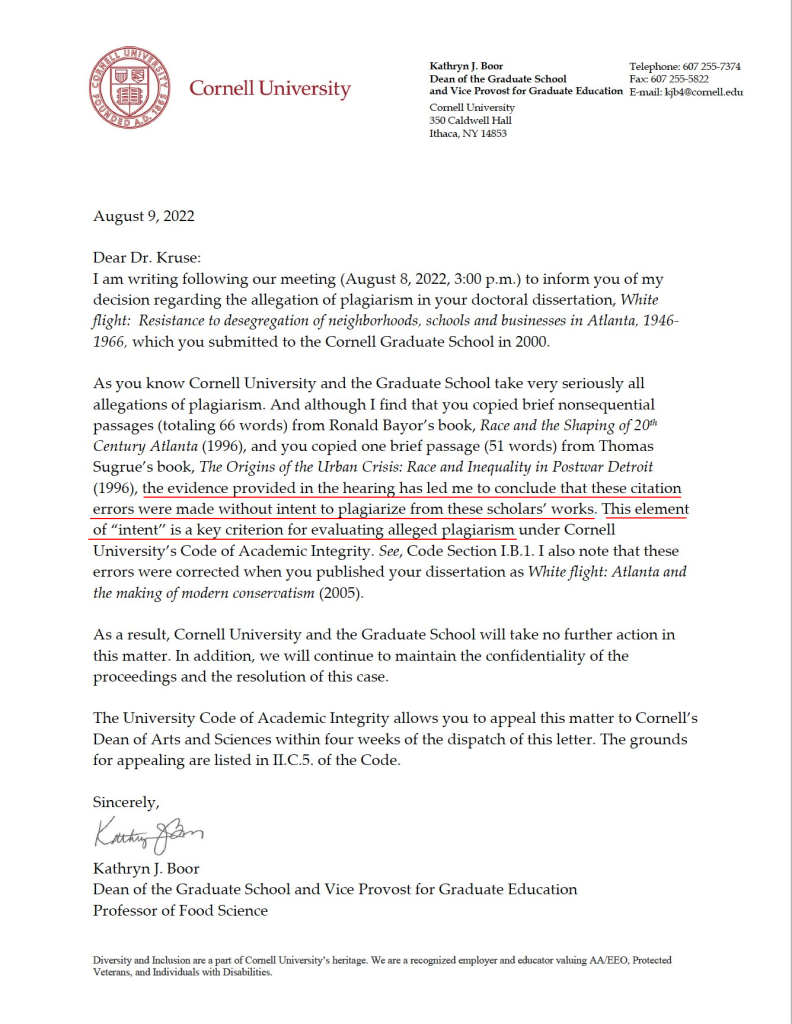

As we shall see, neither university acted honestly or transparently in reaching their respective conclusions. Perhaps the more intriguing issue though is that both universities have extensive written policies for plagiarism when it is committed by students, as opposed to a left wing Twitter celebrity. If simply adhered to in either their letter or spirit, those policies would likely result in a clear finding of guilt. But Cornell and Princeton decided to throw their own policies out the window in order to protect a high profile faculty member.
Defining Plagiarism
While evaluating these claims, a useful starting point is to consider the published plagiarism policies of each university. Cornell University states quite clearly on its academic integrity website that:
“Whether intentional or unintentional, plagiarism is a serious violation of Cornell’s Code of Academic Integrity.”
Princeton’s policy is not only more detailed, it is also even more strict. It states on page 6 that “Ignorance of academic regulations or the excuse of sloppy or rushed work does not constitute an acceptable defense against the charge of plagiarism.” It also specifies what constitutes plagiarism, including a wide range of types and circumstances. The most directly relevant clause is on page 7, and reads:
“Any verbatim use of a source, no matter how large or small the quotation, must be placed in quotation marks or, if longer than three lines, clearly indented beyond the regular margin. The quotation must be accompanied, either within the text or in a footnote, by a precise indication of the source, identifying the author, title, place and date of publication (where relevant), and page numbers. Even if you use only a short phrase, or even one key word, you must use quotation marks in order to set off the borrowed language from your own, and you must cite the source.”
Further elaboration of this policy may be found on page 14, stating
“Inserting even short phrases from the source into a new sentence still requires placing quotations around the borrowed words and citing the author. If even one phrase is good enough to borrow, it must be properly set off by quotation marks.”
In cumulative, Princeton’s policy establishes two conditions that must be met when using words from another source: (1) it must be fully and properly cited, and (2) it must be clearly identified in the text with quotation marks around the borrowed text, “no matter how large or small.”
Princeton’s policy is typical for academia. For example, it closely follows the American Historical Association’s own published standards for plagiarism. The AHA states that:
“Writers plagiarize, for example, when they fail to use quotation marks around borrowed material and to cite the source, use an inadequate paraphrase that makes only superficial changes to a text, or neglect to cite the source of a paraphrase.”
Note that under both the Princeton and AHA standards, a simple footnote alone is not a valid defense against plagiarism if the offending author also copied text without properly identifying it through quotation marks. The AHA illustrates this by example, using a sample paragraph that is plagiarized from another author’s published works. The offending paragraph uses a footnote to the original source, but it also copies the phrasing and text of the original without quotation marks or other appropriate offsetting to designate the wording as another author’s work. The plagiarized example, the AHA notes, retains “too much of the original author’s language and organization.” Even with the footnote, the plagiarized version makes what the AHA calls minor “cosmetic alterations” by changing a few words and failing to place them in quotation marks. This “indicate(s) a lack of synthesis and original thought and represent(s) a theft of [the original author’s] text.”

This brings us to the question at the heart of the current scandal. Does Kruse’s lifting of passages from other authors violate the plagiarism policies of the two institutions where this occurred, as well as the AHA? Cornell and Princeton’s published policies pertain to students. In Kruse’s case, he was a graduate student at Cornell when the first of the alleged incidents occurred. The remainder happened when Kruse was a professor at Princeton, although it stands to reason that faculty should – at minimum – be held to the very same academic integrity standards that they apply to their own students in the classroom. And the AHA, of course is the professional association governing Kruse’s discipline, history
As a final consideration, it is worth noting that Kruse has previously espoused using an extremely strict standard to evaluate plagiarism by students in his own classroom. In 2017, CNN reported on possible plagiarism in a master’s thesis by former Milwaukee sheriff David Clarke. The CNN examination of Clarke’s thesis revealed that he had indeed properly footnoted several blocks of text that he lifted from other sources, however they were not offset by quotation marks or any other indicator to show that they were borrowed words from other sources. Kruse weighed in at the time, declaring the Clarke examples to be “textbook plagiarism.” When other commentators on twitter pressed him to explain this assessment, he doubled down and declared “We’d expel a student who pulled this.”

It’s therefore fair to ask whether Kruse meets the standards for plagiarism that he applies to students in the classroom, in addition to the standards used by Cornell, Princeton, and the AHA. I’ll review the evidence in detail below. It clearly establishes that Kruse engaged in multiple types of plagiarism, across almost two decades of academic work.
Type 1: Borrowed Text Without Citation or Quotation Marks
The most egregious plagiarism in Kruse’s work consists of lifting verbatim passages of text from other sources without either (1) proper citations or (2) appropriate quotation marks. Two clear examples of this type of plagiarism appeared in Kruse’s 2000 doctoral dissertation at Cornell University, and were highlighted in my original article on the subject for Reason magazine.
The first example involves a paragraph of text in which Kruse inappropriately lifted multiple sentences from Ronald H. Bayor’s 1996 book, Race and the Shaping of 20th Century Atlanta.
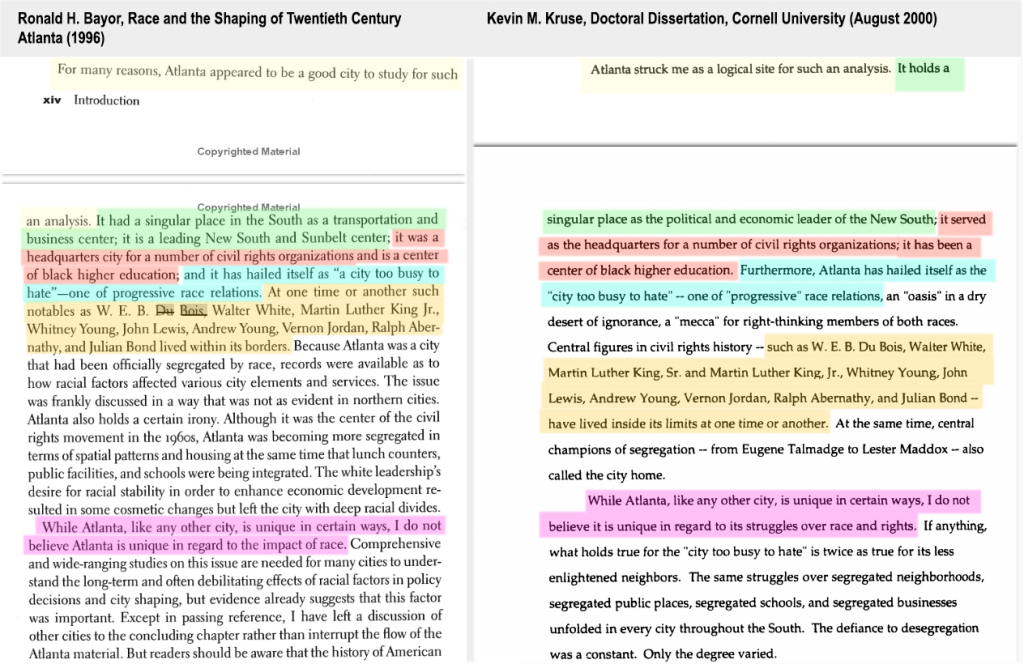
At least one of the plagiarized sentences from Bayor’s book was subsequently copied with minor cosmetic changes in Kruse’s 2005 book White Flight, published while he was at Princeton.

Kruse’s dissertation also lifted a nearly-identical passage from Thomas Sugrue’s 1996 book, The Origins of the Urban Crisis: Race and Inequality in Postwar Detroit.
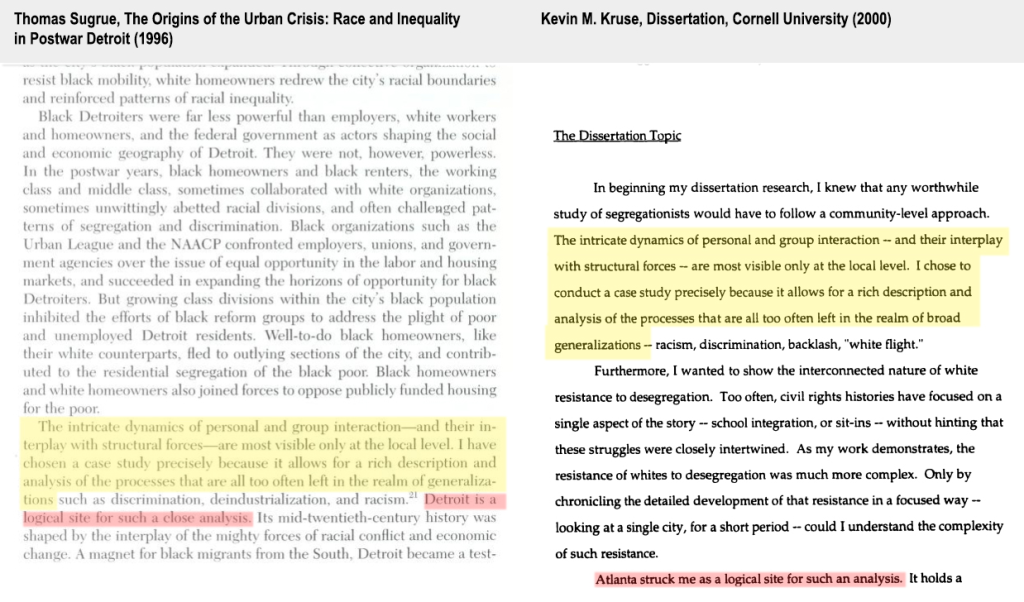
Note that it is particularly difficult to describe Kruse’s use of Sugrue as “unintentional” negligence, despite Cornell’s administration claiming as much. The original passage by Sugrue was written about Detroit. Kruse copied its text, then simply changed the location to Atlanta.
Since the Reason article first ran, several additional suspect passages have come to light from Kruse’s other works. At least one of them lacked both a citation and the required quotation marks. In this example, a passage from Kruse’s 2019 book Fault Lines (co-authored with his Princeton colleague Julian Zelizer) contains nearly-identical language to a passage in Thomas Mann and Norman Ornstein’s 2016 book, It’s Even Worse Than It Looks. Note in particular that Kruse repeats a list of unconfirmed executive branch appointments in the early months of the Obama administration, using nearly identical language and the exact same order as this earlier work.
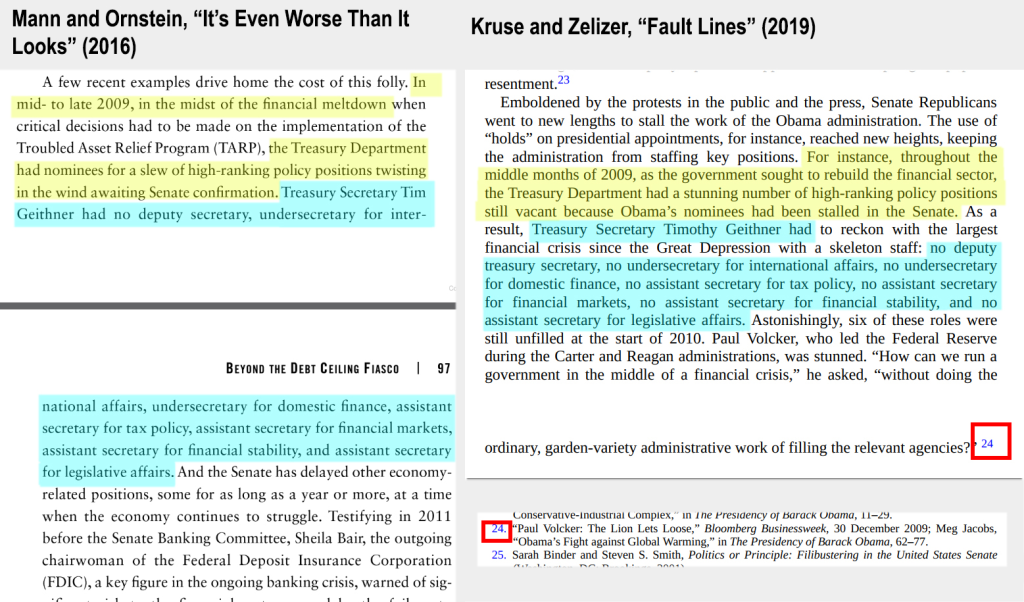
Type 2: Borrowed Text Without Quotation Marks
The next set of examples consist of passages of text where Kruse borrowed identical or near-identical language from a footnoted source, but failed to properly distinguish it through quotation marks. While this type of copying and pasting is sometimes treated as less-serious than examples that also lack a footnote, it still clearly meets the definition of plagiarism as used by Princeton, the AHA, and most scholarly organizations. Princeton, for example, even requires quotation marks around “only a short phrase, or even one key word” of unoriginal text in addition to the required footnote.
I previously highlighted one such example from Kruse’s 2015 book One Nation Under God, which lifted near-identical text from a 1964 hearing report by the House Judiciary Committee. Much like the Clarke thesis that Kruse described as “textbook plagiarism,” Kruse’s own work cited this report in a footnote but failed to offset a large block of clearly copied text through the quotation marks that Princeton’s policy requires.
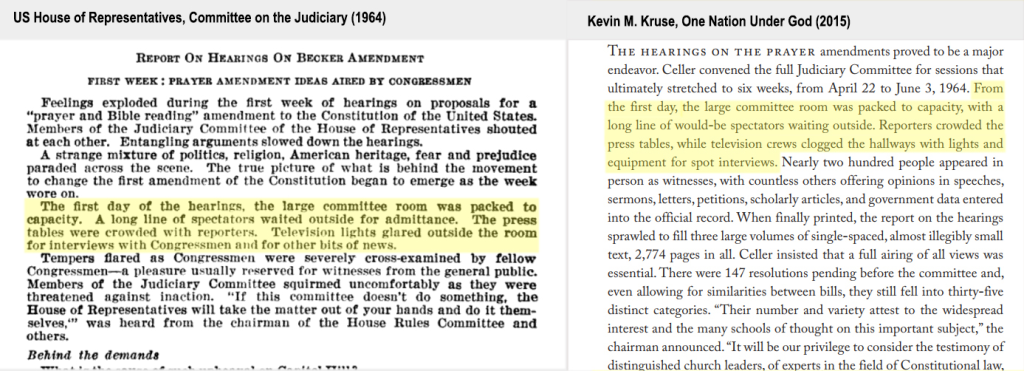
Kruse’s 2015 book One Nation Under God contains many similar instances of partially-footnoted sources that he then lifted text from without the required quotation marks. Another example may be seen here in a passage that was taken from Daniel K. Williams’s 2012 book God’s Own Party: The Making of the Christian Right. Kruse’s version of the same sentence includes nearly-identical phrasing with only a few minor and cosmetic alterations to the wording.
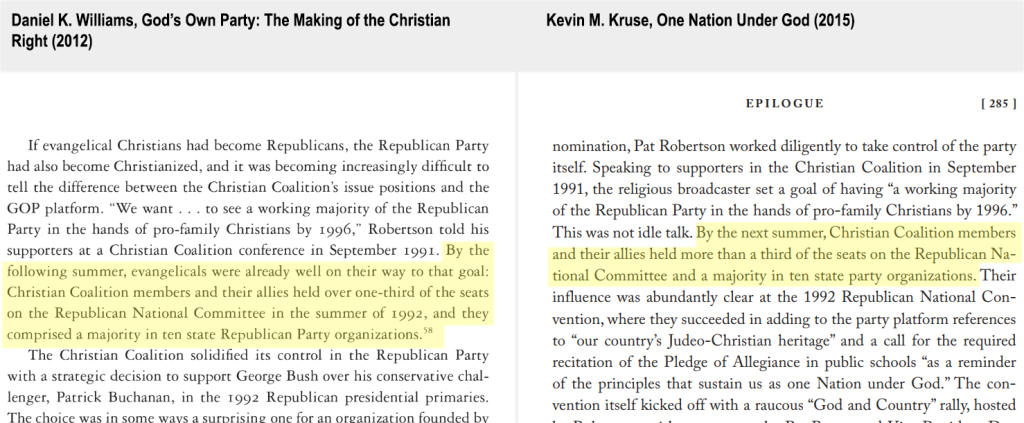
Elsewhere in the same book, Kruse largely copies both the text and structure of a 1954 New York Times article by Elizabeth Fowler. For example, Kruse writes
“Lincoln, aware that the gold supply supporting “greenbacks” was dwindling, joked that a more appropriate motto might be found in the words of the apostle Peter: “Silver and gold have I none, but such as I have give I thee.”” (p. 112)
Compare that to Fowler’s original:
“But it is reported that President Lincoln, mindful of the dwindling gold supply, said that a more appropriate motto for the greenbacks might be the remark of the Apostle Peter: “Silver and gold have I none, but such as I have, I give Thee.””
Numerous other examples are lifted from Fowler. Speaking of the national motto on coinage, Kruse writes “It soon appeared, on bronze 2¢ pieces, in 1864,” which is clearly cut and pasted from Fowler’s “It first appeared on the bronze two-cent piece of 1864.”
This same book contains other examples of similar copying without the required quotation marks. One example that came to light after the Reason article shows almost four straight pages in which Kruse copied and lightly edited the description of a speech by Richard Nixon from Rick Perlstein’s 2008 biography Nixonland. Although Kruse does cite Perlstein in a footnote, his text lacks the required quotation marks around several nearly-identical sentences. It also closely copies the structure and presentation of Perlstein’s book over several pages, which the AHA policy classifies as an “inadequate paraphrase.” Rather than conducting original research on the Nixon speech, Kruse simply copied the exact same quotations from the speakers and news reports that Perlstein collected and curated seven years earlier in his own original work.
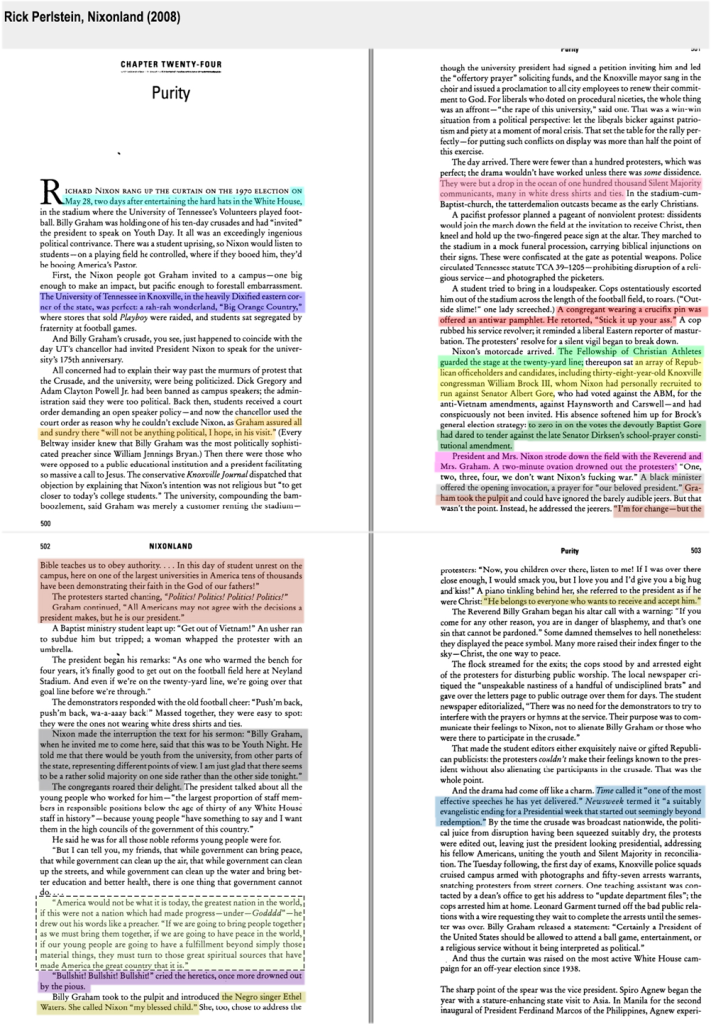
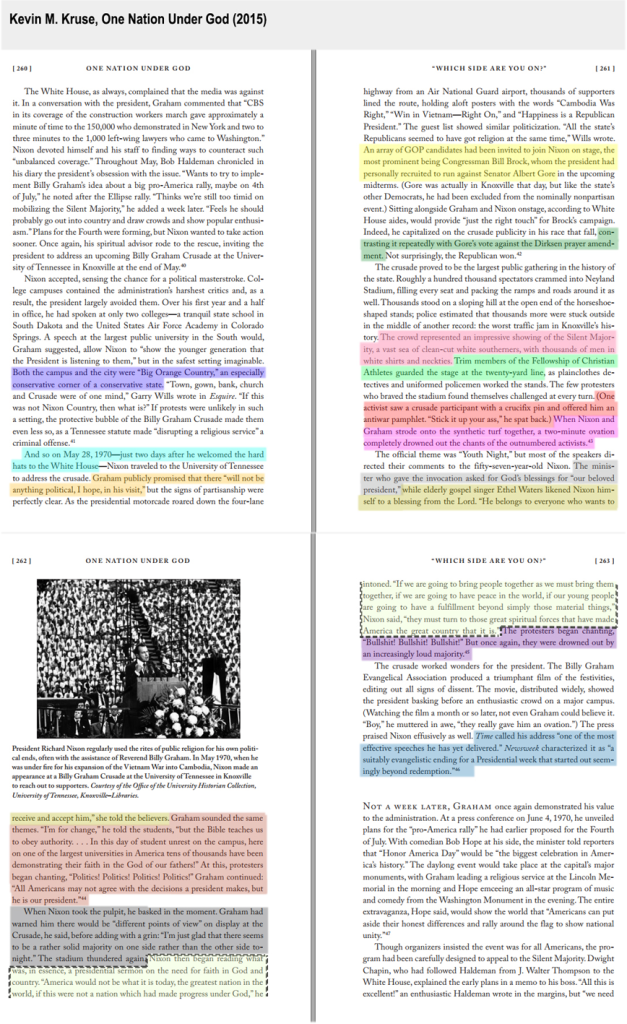
All said, it is a tactic befitting of a lazy and plagiarized term paper by a procrastinating undergraduate on the night before the due date. But Kruse is an Ivy League professor, and his book One Nation Under God was presented as an original scholarly contribution.
Perlstein is not the only victim of Kruse’s cutting and pasting. A number of similar examples appear in Kruse and Zelizer’s 2019 book Fault Lines, including this passage. It is cited to a 2012 news article by Time magazine reporter Michael Grunwald, but lacks the required quotation marks around a sentence structure that is a lightly-edited cut and paste from Grunwald’s story.
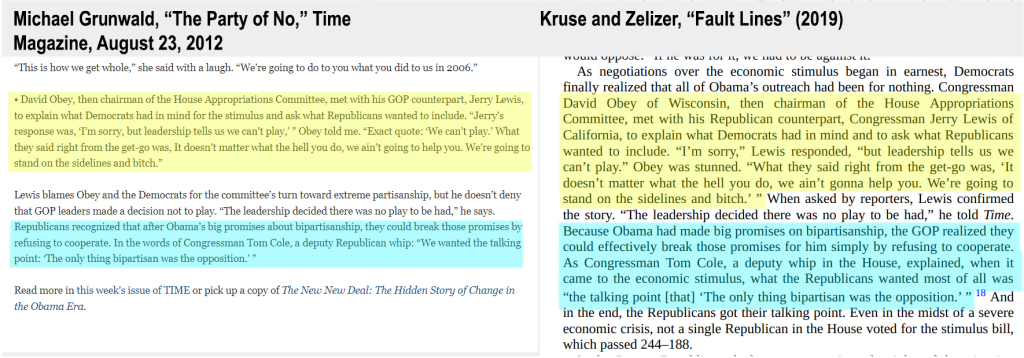
In another example from Fault Lines, Kruse and his co-author cut and paste a passage from a 2004 news article in Wired Magazine, footnoting it but also failing to indicate that it is another author’s text through the required quotation marks.
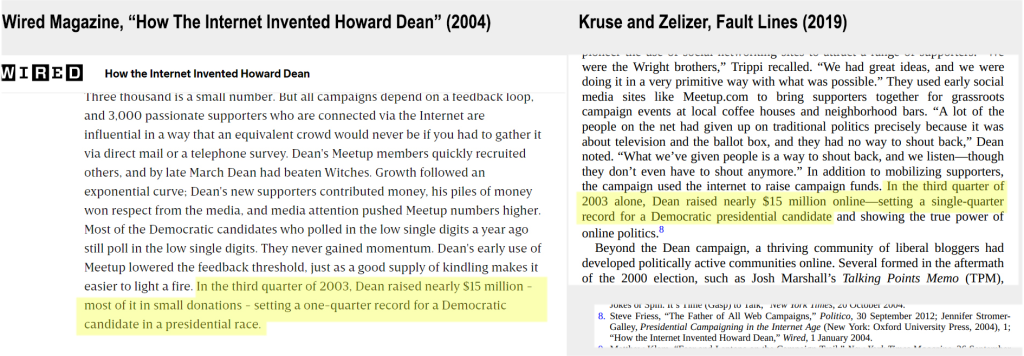
In another example from the same book, Kruse and his co-author cut and paste a nearly identical passage from Bruce Schulman’s 2001 book The Seventies. It is footnoted to the page of the original, but also clearly lacks the required quotation marks around text that originates from another author.

Other passages of this type appear in several of Kruse’s works, accompanied by footnotes but also lacking the required quotation marks. In each case, the words used are taken verbatim from the original source, or lightly rearranged as if to disguise the fact that they are cribbed from another person’s work. Again as per Princeton’s policies, these passages all fail Princeton’s requirement: “Any verbatim use of a source, no matter how large or small the quotation, must be placed in quotation marks.”
Type 3: Excessive Paraphrasing
A third type of potentially problematic material appears in Kruse’s other works: the excessively close paraphrase. This practice is condemned in the AHA policy. It often sits on the boundary of plagiarism or other forms of academic misuse, but it represents lazy scholarship at the bare minimum and may portend something worse, depending on the case.
One particularly severe example of an excessively close paraphrase may be found in Kruse and Zelizer’s Fault Lines, where they recount a series of historical events about the rise of feminism in the American workplace. A careful examination of Kruse’s paragraph reveals that it is little more than a sloppy rewriting of its footnoted source, Beth Bailey’s 2004 book She Can Bring Home the Bacon: Negotiating Gender in Seventies America. Some of the passages in this paragraph are presented in near-verbatim form, lacking the required quotation marks. Others take Bailey’s words and slightly rearrange them, swapping out a few words with close synonyms. In any case, the similarities are pronounced and comprise almost the entirety of Kruse’s paragraph. Kruse also clearly copied the ordering and structure of Bailey’s argument, signifying a lack of originality in his work.
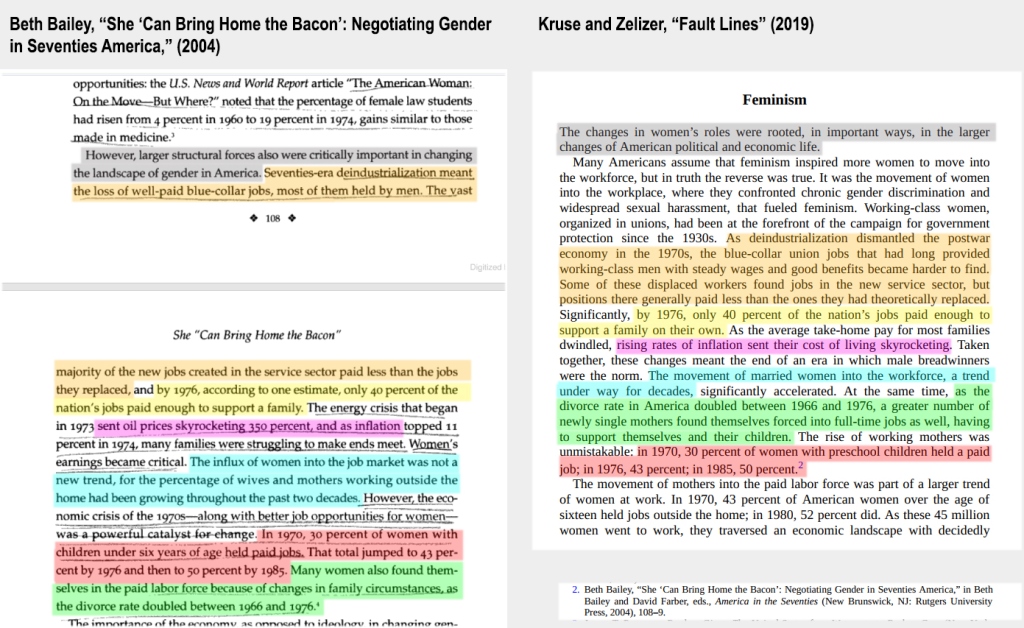
Conclusions
These examples illustrate a recurring pattern of at least three types of academically suspect behavior in historian Kevin M. Kruse’s works: (1) plagiarism, consisting of copied text without any citations or quotation marks, (2) plagiarism, consisting of copied text with a footnote but no quotation marks around the lifted material, and (3) excessively close paraphrasing of another cited author’s text, which organizations such as the AHA classify as unethical due to its lack of originality.
Recall that throughout his academic career Kruse has aggressively espoused applying strict standards for plagiarism against other author, including advocating harsh penalties for offenses that are substantially less egregious than his own. In almost all of these cases, the accused plagiarist comes from a different political perspective than Kruse.
The David Clarke plagiarism case is but one of many instances. Examples of Kruse’s denunciations of others for plagiarism are an ubiquitous feature of his twitter feed:









In light of these and similar remarks, we may conclusively state that Kruse’s academic work fails the very same standards he applies to other people in evaluating plagiarism – and fails spectacularly. Sadly, Princeton and Cornell Universities have chosen to conveniently overlook clear evidence of Kruse’s academic misconduct on account of his political beliefs and his Twitter celebrity status. In doing so, they have sent an unintentional signal to their own students. Plead carelessness and invoke your record of far-left political activism, and you too can claim an exemption from the written academic misconduct policies of your university.